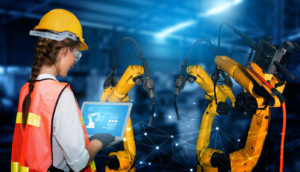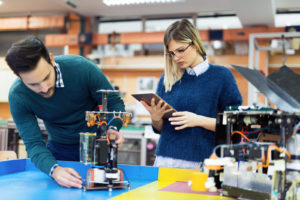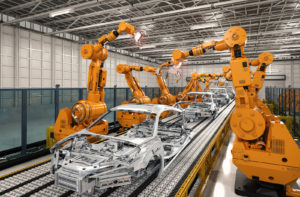Mechatronics Engineering

TRYENGINEERING CAREER PATHWAYS
Mechatronics Engineering
Mechatronics engineering is a field that is somewhat similar to mechanical engineering — but as the name indicates, those working in this area are bringing both mechanical and electronics engineering skills to their work. Mechatronics represent technology integration, however, and is not simply a combination of primary disciplines. While mechanical engineering focuses on mechanics, control, manufacturing and power, mechatronics engineering focuses on the design and development of electro-mechanical devices. These can be large scale automation for manufacturing, such as robotics, or micro-scale instruments such as sensors – it can be consumer products, or self-driving cars.
The word mechatronics was coined by Tetsuro Mori, an engineer of Yaskawa Electric Corporation, and was trademarked in 1971. However, the company later released the right to use the word to public, whereupon the word began being used across the world, and now represents an interdisciplinary field where the goal is to develop design solutions that unifies mechanical, electrical, and other technical areas.
What makes it unique?
Mechatronics is a field that requires the blending of mechanical, electrical, and computing skills to develop or improve products or systems. These skills have many applications in multiple industries, and day to day activities draw upon different skill sets.
 Degree Connections
Degree Connections
The following are examples of some accredited degrees leading to a career in mechatronics:
- Mechatronics
- Mechatronics Engineering
- Mechatronics Engineering Technology
- Electromechanical Engineering
- Electrical Engineering
- Electrical Engineering Technology
- Mechanical Engineering
- Mechanical Engineering Technology
Search our global database of accredited engineering programs.
Want to learn more?
Click on the blue tabs to explore the field in more detail and learn about preparation and employment, the green tabs to be inspired by people working in mechatronics and how they impact the world, and the orange tabs for ideas on how to learn more and you can get involved with activities, camps, and competitions!
Explore

Mechatronics efforts require working in or leading design team which may consist of specialist engineers as well as generalists. In mechatronics, products are developed through a systemic approach, and this requires extensive meetings as well and time spent overseeing production or installation of new products or systems. Individuals employed in this field will work in an office setting but will also spend time at client locations or manufacturing facilities. They might examine a factory setting and consider how robotics might be improved with additional sensors to meet the needs. Especially with new product development, mechatronics engineers might be called upon to put in extra hours during key points in product development, but these are generally predictable.
Autonomous Vehicles:
Automotive mechatronics involves the integration of automotive mechanical and electronic systems. A great example of a mechatronics achievement is the control system that enables self-driving vehicles. Those working to develop and improve these systems work across automotive-specific mechanics, including sensors, electronics, communication, and modeling.
Sensors are particularly important to self-driving cars so they can gauge surroundings and vehicle data. Vehicles need to use GPS to determine location, determine the speed of the car, identify other vehicles or navigation guidelines and also be able to interpret signs, road pathways, and obstacles.
Experiments have been conducted in this area since the 1920s, but the first semi-automated car was developed in 1977, by Japan’s Tsukuba Mechanical Engineering Laboratory. Since then many companies and governments have worked on both technology and regulations for these vehicles. And testing and trials continue! Teams of engineers are continually working to perfect this achievement in a way that will ensure safety for riders and other vehicles.
Tesla claims that “all new Tesla cars come standard with advanced hardware capable of providing Autopilot features today, and full self-driving capabilities in the future—through software updates designed to improve functionality over time.”
The video to the right shows how Bosch has developed multiple sensors to help control self-driving cars!
Explore more details:

Many industries employ mechatronics engineers, including automotive, aerospace, consumer goods, energy, manufacturing, healthcare, and transportation. Governments also employ mechatronic engineers as part of their research and development programs, as do universities and other research centers.
Some examples of efforts mechatronic engineers might work on in these industries are micro grid engineering (working on improving the electric grid system), 3-D printing systems, driverless technology, and even swarmbots which can repeat tasks on a miniature scale.
The following is just a very short sample list of some companies, outside of government, who employ mechatronic engineers:
For most engineering careers:
- a bachelor’s degree is required

bigstock.com/World Image - a master’s degree may be recommended for those specializing or interested in management
- students may also start with a related associate degree and then move on to a bachelor’s when they have settled on a degree path.
- many students are required to participate in a co-op program while at university to gain real world experience in their chosen field.
- education doesn’t really stop…engineers need to stay current as technology changes and materials and processes improve over time.
- many professional societies offer certificates and coursework to support continuing education for their members.
At the undergraduate level, mechatronics engineering courses will cover mechanical engineering topics but generally in the second or third year courses will focus on systems design engineering and electrical and computer engineering. It is a very interdisciplinary degree. There are also certificate and masters programs in mechatronics which can add a layer of expertise for those with undergraduate degrees looking to specialize further.
It is important to select an engineering degree that has been accredited to meet basic standards. Find out more and browse TryEngineering’s global database of accredited engineering and computing programs.
Be Inspired
The following links offer more chances to see what people are doing in the field of mechatronics engineering:
- Jean-Paul Laumond is a robotician, research director at the CNRS, the French National Centre for Scientific Research. In the interview to the right from IEEE TV, he discusses his movement from mathematics to robotics and his career contributions to the field, especially in regards to motion planning and anthropomorphic motion.
- Kevin Craig, one of the leading advocates for mechatronics. He supports mechatronic model-based, human-centered design that can serve as a process to solve the world’s and society’s most urgent needs in the areas of energy, poverty, water, shelter, health, education, and climate.
- Veronica Santos is Director of the UCLA Biomechatronics Lab and is interested in hand biomechanics. View her seminar on Helping Hands here.
- Joseph Engelberger “The Father of Robotics.”
- George D. Devol was the inventor of the first programmable industrial robot.
George Devol’s invented the world’s first programmable industrial robot – and the world of manufacturing has never been the same. It was conceived from a design for a mechanical arm! He was aware he would face challenges related to workforce displacement and so he applied robots first to tasks that were potentially harmful to humans.
The first robot was named Unimate and it first worked on a General Motors assembly line in 1961. It transported die castings from an assembly line and then welded the parts onto auto bodies. This was a dangerous task for workers, who might be poisoned by toxic fumes or potentially lose a limb if there was an accident.
Applications soon grew and many companies were launched to develop robots in a range of settings. They soon incorporated sensors and other tools to adapt to tasks such as sorting and assembly. The result was an increase in production speed, a reduction in costs of manufacturing, and also loss of jobs for many workers. Many companies worked hard to support workers who needed new skills for different jobs.
Typical applications of robots include welding, painting, assembly and disassembly, component selection, product inspection, parts sorting, packaging and labeling, palletizing, and testing. Over the decades, industrial robots have had a global impact by speeding up manufacturing of needed drugs or vaccines, developing faster manufacturing of a replacement part for an automobile recall, or simply getting a product into the hands of consumers faster and at less cost. The robotics market was valued at USD 23.67 billion in 2020 and is expected to reach USD 75+ billion by 2026.
Find out more:
Get Involved
Dig deeper into topics related to mechatronics engineering that interest you!
Explore:
- What is Mechatronics? (IMechE)
- IEEE RAS Robotics History
- Robots IEEE
- George Devol: A Life Devoted to Invention, and Robots (IEEE Spectrum)
- Mechatronics and the Role of Engineering (ASME)
- TryEngineering News Blog: Want to be a Robotics Engineer?
Watch:
- Kevin Craig discusses the field of Mechatronics (video at right)
- What’s it like to be a Mechatronic Engineer? Watch Curtin University alumnus Joshua Portlock describe how he got into the field. He focuses on “flying robots.”
Try it Out:
- TryEngineering Live: Hands-On Design Challenge with Robots.ieee.org
- Try one of the TryEngineering lessons that focus on mechatronic engineering:

Clubs, competitions, and camps are some of the best ways to explore a career path and put your skills to the test in a friendly-competitive environment.
Clubs:
- Many schools have coding groups or robotics clubs for students to build and test robots for competitions. This is a great way to get some early mechatronic engineering experience.
Competitions and Events:
- IEEE Robotics & Automation Society offers a list of robotics competitions and other educational resources.
- FIRST Robotics Competition teams design, program, and build a robot starting with a standard kit of parts and common set of rules.
- Institution of Mechanical Engineers Apprentice Automation Challenge provides a brilliant opportunity for talented apprentices to compete in an innovative design and manufacturing challenge to improve an everyday home or garden device.
- Global Summit and Expo on Mechanical and Mechatronics Engineering offers a Young Scientists Forum
Camps:
- TryEngineering Summer Institute, US: Attend the TryEngineering Summer Institute to further your core engineering skills.
- Robotics Institute: International Robotics Camps for Girls
- NASA Robotics Summer Camps
Many universities offer summer engineering experiences. Reach out to your local university’s engineering department to see what they offer.

Did you know you can explore mechatronic engineering in your community? Consider the features in your family car, or perhaps your school bus or local train.
- Are there sensors in your car? Some examples are cameras in the back of the car to alert the driver that they are too close to an object behind them. How do these sensors work and how do you think they are incorporated into the car and the display system to alert the driver?
- How do sensors alert the driver? Does the light flash on the dashboard if the fuel is too low? Does the horn sound if the driver reverses the car and is too close to an object? Do the brakes engage if the car senses a pedestrian walking in front of the vehicle? How many systems within the car need to be integrated to allow this to happen?
- Some cars have speed devices to alert new drivers if they are exceeding the speed limit. What systems must be in place for this to work properly? How would the car know what the local speed limit is? Would they need to read a speed limit sign? Use GPS? Rely on some other online database of information related to their global position?
- Does a school bus have any integrated safety features that involve hardware, software, and sensors?
- Some cars will not turn on if the driver does not have their safety belt engaged. What systems and sensors must be in place for the car to prevent ignition?
- Most cars have sensors to determine if someone sitting in the front seat is under a certain weigh threshold and therefore might be injured if the air bag went off in an accident. How many sensors can you think of that would be required to achieve this task?
Find out more:
- Collision-Avoidance Systems Are Changing the Look of Car Safety
- US Department of Transportation: Driver Assistance Technologies

Be sure to reach out to professional societies focused on mechatronic engineering where you live. Not all will offer membership to pre-university students, but most offer groups for university students, and certainly offer online resources to help you explore the field.
Some examples of groups focusing on mechatronics engineering:
- IEEE Robotics and Automation Society, US
- Institute of Mechanical Engineering UK Mechatronics, Informatics and Control Group
- International Federation of Robotics
- International Society of Automation
- International Society of Mechatronic Engineering
- Robotics Industries Association
- Society of Manufacturing Engineers
- The American Society of Mechanical Engineers
Some resources on this page are provided or adapted from the US Bureau of Labor Statistics and the Career Cornerstone Center.






















